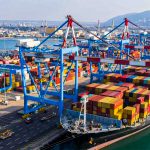Listen to the audio version of the blog here:
Europe logistics market is having a makeover right now, and it is sponsored by the blooming e-commerce industry, emerging technologies, green logistics and the rising demand for 3PL.
The Europe logistics market size, which was valued at USD 2353.88 Billion in 2024, is forecast to increase at a CAGR of 5.40% between 2024-2034, reaching a value of USD 3982.82 Billion by 2034. More than just the market size, this signals a fundamental shift in how logistics work, moves and scales across the continent, and this shift is shaped by specific forces that are moving the industry forward.
The rising demands of e-commerce industry
As online purchases have become the new norm, the demand for last-mile logistics and warehousing options has increased more than ever. Customers demand fast deliveries, real-time tracking and easy returns. This has pushed logistics providers to rethink fulfilment strategies, such as investing in urban warehouses, automating inventory and improving last-mile delivery in Europe. Cross-border e-commerce logistics are also growing, increasing the need for seamless international shipping and customs clearance. This shifts the focus to customer-centric logistics in Europe, which slowly transforms the entire process to enhance the satisfaction of the customers.
The rise of 3PL logistics
As the demands rise for last-mile deliveries, companies in Europe are leaning on third-party logistics providers to handle everything from warehousing to freight forwarding, increasing the demand for 3PL market in Europe. 3PL saves costs and comes with built-in expertise, and has become essential in industries like healthcare, pharmaceuticals and retail. With more cross-border traders, 3PL also offers ready-made networks and tech platforms that brands can rely on.
Integration of technological advancements
Technology is doing more than just supporting logistics. It is actively transforming it. Tools like artificial intelligence improve demand forecasting, and the process of predictive analytics plays a crucial role in optimising multi-modal transport in Europe. While IoT-enabled devices and sensor technologies also offer real-time monitoring capabilities, technologies like warehouse management systems (WMS) and transportation management systems (TMS) are improving efficiency, accuracy and visibility across the supply chain. Integration of these technologies takes the logistics in Europe sector to faster, smarter and more accurate logistics operations, from the first mile to the last.
Increased focus on sustainability
Environmental awareness that is now gearing up the world is making logistics invest in sustainable logistics practices, such as electric vehicles. Moreover, multi-modal logistics are optimised with the help of AI technologies to reduce carbon prints. From packaging to transportation, there is implementation of sustainable resources in the industry to become future-ready.
Redefining logistics in Europe
Logistics in Europe is shifting from just moving products to a field of structure, speed and strategy. With growing demand from e-commerce, smarter technologies, strong push for sustainability and demand for 3PL services, the way goods move across the continent is being redefined in Europe. It is now all about moving smarter and greener.



